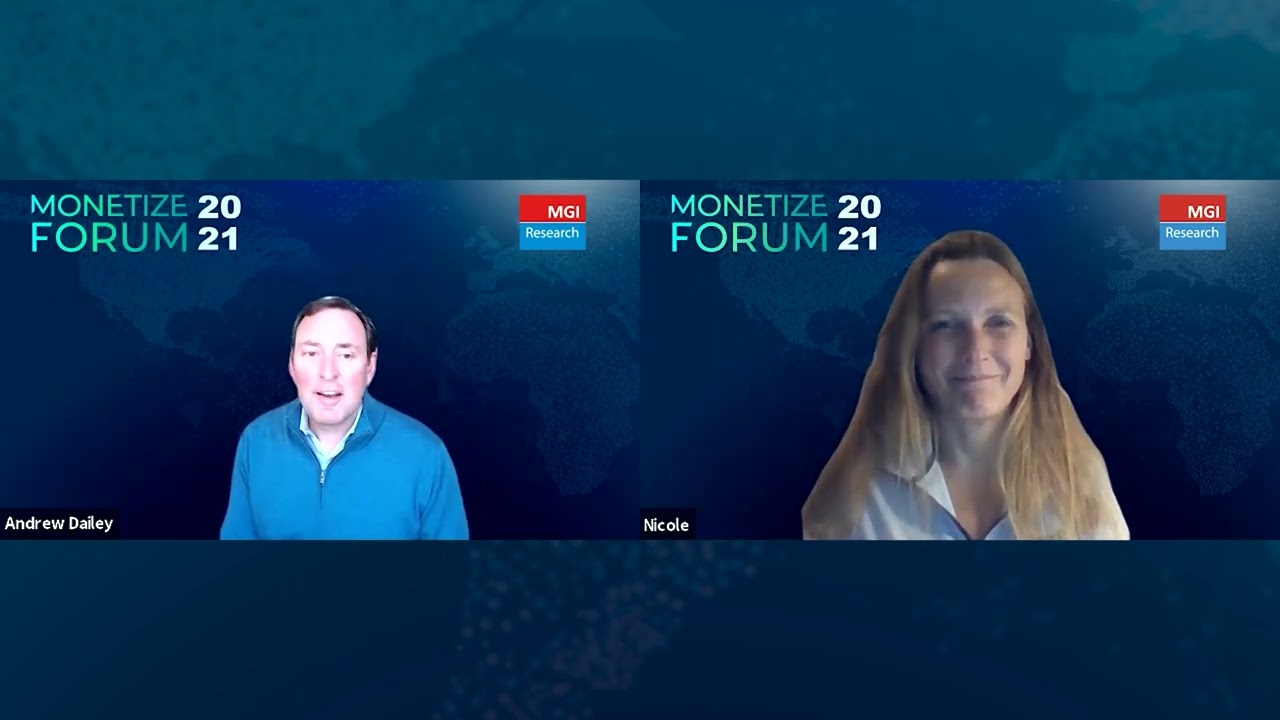Usage-based services are rising in popularity, especially post pandemic as customers consider uncertain futures and budgets. However, the complexity involved in adopting a usage-based business model has kept many that want to make this move from actually taking the plunge. To get the view from a usage expert, MGI Research analyst Igor Stenmark spoke with Andreas Zartmann at the 2021 Monetize Forum. Andreas is the CEO of DigitalRoute and brings his experience in the traditionally usage-based telecom world to helping businesses make the switch in other industries. In this conversation, he explains why usage is the future and how the data it provides can play a key role in opening up new revenue streams.
Key Issues
What are the barriers to adopting a usage-based revenue model?
What is a usage data platform, and how can it address the gaps left by middleware solutions?
What are the main culprits behind revenue leakage?
Guest Profile
Andreas joined DigitalRoute in 2012 as CFO. He was appointed CEO in 2017 and has led the rapid growth of the company as businesses across industries switch from selling products to selling usage-based services.
Prior to DigitalRoute, Andreas held key executive roles as CFO at various information technology and telecom companies as well as in investment banking and management consulting
Igor Stenmark
Hello, this is Igor Stenmark of MGI Research at the 2021 Monetize Forum conference. Every year, there’s a lot of chatter in the industry about the increasing adoption of usage-based pricing, and this is evident in our field research, advisory work, and conversations with both users and suppliers. There have always been extensive applications of usage-based models in areas like telecom and utilities, but what about the broader industry? How close are we to a real inflection point and the adoption of usage-based models beyond telecom?
The pandemic has really pushed many planners to think about the opportunity of consumption-based models from a totally different angle. What once was seen as an exotic option is now clearly a strategic approach to potentially get real market share. So, in our next session here, we’ll focus on key concepts of what’s described by some as the usage economy, with a heavy emphasis on consumption-based models. This area is also known in the industry as mediation. We’ve actually published a few notes on this topic, and we often refer to it as “Mediation 2.0.”
We have the perfect person to join us today—Mr. Andreas Zartmann, the CEO and business brain behind DigitalRoute, a global provider of revenue data management technology. I’ll let him introduce the company in a moment. Andreas has extensive experience in the software and technology industry across a spectrum of stages of maturity. He has been with startups as well as some very large, publicly traded companies. Andreas joined DigitalRoute in 2012 as a CFO. In 2017, he became a CEO and is now driving the next phase of this company’s growth. Prior to DigitalRoute, Andreas held key executive roles in various software and technology companies, was a management consultant, and also worked as an investment banker. So, his breadth and depth of expertise drive this company and make him the perfect guest to discuss the issue of usage and consumption-based pricing. Andreas holds an MBA from Linköping University in Sweden.
Andreas, welcome to Monetize Forum 2021. Let’s jump right in and talk about the usage economy here. We have a lot of questions for you today, but to begin, give us a brief introduction to DigitalRoute.
Andreas Zartmann
Sure. First of all, thank you very much for the introduction, Igor. I’m very happy to be part of the event. DigitalRoute is a Swedish tech company that provides purpose-built technology to enable the world’s leading brands to shift their business models from one-time product sales to usage-based revenues. We were born and raised in the telecom industry where we gained 20 years of experience building and enabling software for the most demanding quote-to-cash processes there are. Today, over 400 companies across various industries rely on our usage data platform for usage-based monetization, quote-to-cash automation, finance system modernization or consolidation, and, of course, telecom 5G mediation—that’s a big business for us.
Igor Stenmark
Great. So, a lot of companies talk about adopting new business models. They say, “We want to grab market share. We currently have a basic subscription, and we want to marry it up with some sort of consumption-based model. We want to do prepaid, or maybe postpaid…” Often, all that is just talk, and there are a lot of barriers to adoption. What do you think is holding companies back?
Andreas Zartmann
That’s a great question. The simple answer is that this shift in business models, and specifically to usage-based business models, is not easy. Usage-based business models are pretty complex under the hood, and this shift not only affects billing but also all the applications that are part of the quote-to-cash process. All of these applications need clean usage data in order to keep the revenue records right in the ERP system at the end of the process—the ultimate goal for the process.
On top of the difficulty of transformation, companies are dealing with rapidly growing data volumes. This adds to the complexity and causes a lot of new problems through a lot of dirty and low-quality data. Additionally, the enterprise IT landscapes are very, very complex—frequently more complex than telecoms where we have standards for almost everything. Enterprises have to deal with many legacy systems and mainframes and now new cloud systems. They also have to deal with generations of data.
Usage data resides in a wide range of disparate data sources you need to collect from, and that needs to happen in real time at very large volumes. You then have to turn this raw data into the high-quality dataset that you need for recording the usage-based revenue—without any loss at the same time. So, enterprises need to solve for these problems without having to rebuild their entire IT infrastructure. To summarize, it’s a damn complex transformation to solve for, and now ultimately, all these challenges in the transformation to new business models are driven by data challenges.
Igor Stenmark
So, it sounds like data, data, data: data fidelity, data speed, data volume, data consistency, data cleanliness, and so on. There are a lot of aspects that people need to take care of. When companies are trying to make a move, say, from a basic pricing model to a consumption or usage-based model, what advice would you give to the CEOs, CIOs, and CFOs who are considering this and thinking, “Well, we have enough technical depth to really handle that. We have good people”? What sort of advice would you share with us and the audience, and what are some of the use cases, stats, and major benchmark markers?
Andreas Zartmann
First of all, don’t hold back. I think that’s the main advice. Usage-based services are definitely the future. It’s a better deal for your end customer, and you’re getting closer to your end customer. Additionally, it’s ultimately a more sustainable model as well, so even though there’s complexity, there’s a huge untapped revenue opportunity to grab. It’s proven that companies with usage-based business models grow faster than those only using flat fees.
Secondly, all of this starts with data, as we just said. It’s a digital business model, so get control of your usage data specifically because the core of every digital business model is usage data. If you control your usage data, you can open up new revenue streams; it’s as simple as that.
Number three is making sure you build a quote-to-cash process that is flexible enough to adapt to new business models and built for scale from the very beginning. Your business models will change as demand changes, so you need to be able to easily offer new kinds of services based on usage, and your data volumes will definitely not stop growing. Take that into account from the very beginning.
Number four is to not build this solution to process that usage data yourself. Over and over again, we see how homegrown solutions lead to loss of data, which at the end of the day is loss of revenues. Instead, start with a platform that’s purpose-built for monetized usage-based revenues.
Igor Stenmark
It sounds like, in conclusion, go find an expert who has done it before at a few hundred companies.
Andreas Zartmann
That’s a good conclusion.
Igor Stenmark
I think that’s pretty sage advice in something as complex as that. As you know, we have this reference model which we call Agile Monetization Platform or AMP. I’m not going to show it here, but it looks like a data bus, and we use this graphic throughout the conference here and in our research. The data bus essentially connects all the major disciplines; things like billing and the financials are all hanging off the data bus and sharing information, data, and events. In many ways, I guess what you guys do is essentially a data bus, and you describe it as a usage data platform. So, what exactly is your product? What’s your offering, and what do you guys do?
Andreas Zartmann
Yes, so firstly, I think we like the position that you refer to in your picture: being the element that connects the various financial systems in the quote-to-cash process. However, we don’t like that “bus” word because we’re much more than a data bus. First of all, the usage data platform is purpose-built to orchestrate and monetize usage data. I think that’s very important. We like to talk about it as the three components of mediation, usage management, and entitlements together to collect, transform, and process data from any kind of data source, at any kind of volume, and without any data loss.
We clean, aggregate, and correlate that data and enrich it to that golden record you need for recording revenues—that’s basically mediation if we simplify it. On top of that, we add in the intelligence in our usage management solution, and that is about enabling complex business models to innovate on top of what you already have. Then, you wrap that up with business logics and the rules around the business models that you’re offering your end customer. That’s often referred to as entitlements (or policy controls, as we used to call it in telecom). All three components together complete a very powerful, reliable engine designed from the very beginning to simplify the complexity that we talked about when it comes to usage-based revenues.
Igor Stenmark
It sounds like if you have very complex billing or quotation requirements, the complexity is often because of the usage data, and without a usage data platform of some sort, it will remain very complex.
Andreas Zartmann
Right.
Igor Stenmark
Also, before you solve it, try to first simplify the problem by using something like a UDP. Looking at your product, I think a lot of people in our audience will think, “This sounds like application integration middleware, maybe like MuleSoft.” And in fact, MuleSoft is owned by Salesforce, and you guys are partners with Salesforce and have joint customers. What do you guys do there? What problems do you address that cannot be solved by traditional middleware products?
Andreas Zartmann
That’s a great question and one that we often hear in discussions with our customers very early in the process as well. To start with, middleware products are built for purposes other than monetizing usage data—mainly for integration between applications. You’re right, our partners all have many different middleware or data integration tools (great products, by the way). And we’re often seen together, and I believe we always co-exist in the same architecture but for different purposes. So, that’s very important.
As opposed to these tools, the usage data platform is purpose-built for monetizing usage data, and we are trusted by our customers to handle their data for usage-based revenues. This trust is built on requirements from the business, requirements from finance, and requirements from compliance. On top of solving for the complexity and volumes that we were talking about before, we perform and process very complex business logic, which, at the end of the day, turns into revenues. If anything goes wrong, you start to leak revenues.
I think the distinction between ESBs, ETL, middleware, and then our platform was actually sharpened in the telecom industry where requirements for data volumes and solving for massive complexity (both from the business model itself and from the IT landscape) increased to a level where there just needed to be a specific, standardized software to handle usage-based revenue. That’s where we were born and raised, and that’s what we’ve built and solved for during the past 20 years.
Igor Stenmark
Andreas, you mentioned revenue leakage. We track that, and it’s a very popular topic with many of our clients in the finance industry. We estimate that leakage is an average 3% to 5% of revenues, and there are estimates out there from large accounting firms like EY that cite even higher figures. In your view, what causes revenue leakage? How is that related to usage-based data, and how do you eliminate that?
Andreas Zartmann
To keep it fairly short and simple here, there are three main areas that cause revenue leakage. The first is siloed architecture, and actually, most often there are too many middleware elements—while we’re talking about that. A large amount of revenue leakage occurs in the back office as a result of having more than one platform responsible for orchestrating usage data between applications because this is a process, as we know. But that kind of architecture causes a lot of errors as these systems are not built for the data quality required for monetization and revenues at the end of the day.
Secondly, there’s tons of manual work. We’re dealing with multibillion-dollar businesses, very large enterprises with big teams handling massive amounts of manual work inserting data into Excel files, manually sending emails to trigger the next process in a chain, et cetera. The lack of persistent automation of data management’s main processes is really a key driver for revenue leakage.
Number three is volume of data. The simple truth is that when applications cannot cope with volume, they start to lose data, resulting in revenue leakage. We see over and over again that overloading back-end systems causes crashes that result in a lot of leakage. To solve for these things, implement one platform to manage all of your usage data because that’s equal to revenues. You should also put a lot of demand on that platform for 100% error correction, compliance, audits, and all of that. Then, build robust automated workflows and eliminate all the human errors that occur from having those teams stitching together Excel sheets.
And regarding number three, implement for scale from the very beginning. There are platforms built for scale, and this rapid increase of data volumes is obviously a huge source of leakage problems as well. We’ve invested 20 years in creating this platform which is purpose-built to solve for this problem. So, there is available technology.
Igor Stenmark
If you can, share with us some examples of how your client companies are handling this. What constitutes high volume, and what constitutes big scale?
Andreas Zartmann
Simply put, billions of transactions, of course. A very good example that we often refer to because it shows such tremendous volume is one of the large enterprises in Asia launching new services and onboarding 130 million subscribers onto their platform in 170 days—that’s the kind of volume we’re talking about. Volume is just one aspect, though. There’s complexity as well. When you have many different products that you would like to turn into digital services, you have many different price plans. On top of that, you have many customers that want to consume your services. If you add those three things up, it’s pretty complex. So that’s what’s driving it.
Igor Stenmark
Got it. We’re almost coming to the end of our time slot, but I wanted to ask, what is one thing that no one knows about DigitalRoute but should?
Andreas Zartmann
We earned our reputation as trustworthy over many years by processing usage data for some of the world’s largest revenue streams from some of the world’s best-known brands. If you’re looking at any consumption-based business model or outcome-based business model, come and talk to us. We’ll provide not only technology but also 20 years of experience to make your shift to a new usage-based revenue successful.
Igor Stenmark
Great. Thank you very much, Andreas. We really appreciate you participating in the conference. I’d like to remind everyone that there’s more information available at the DigitalRoute virtual exhibit booth, and I’m sure that Andreas and his team would be happy to answer any additional questions. We’re out of time, so I’d like to thank everyone for joining us today. Please enjoy the rest of Monetize Forum 2021.
Andreas Zartmann
Thank you very much, Igor.




